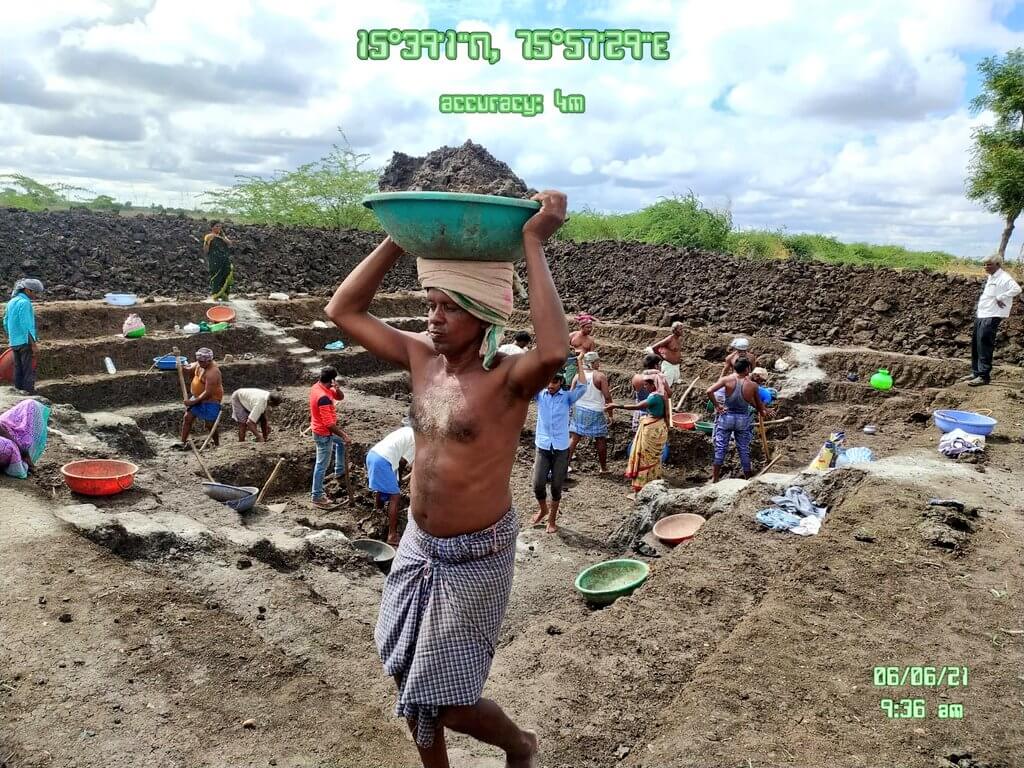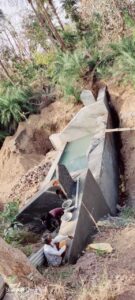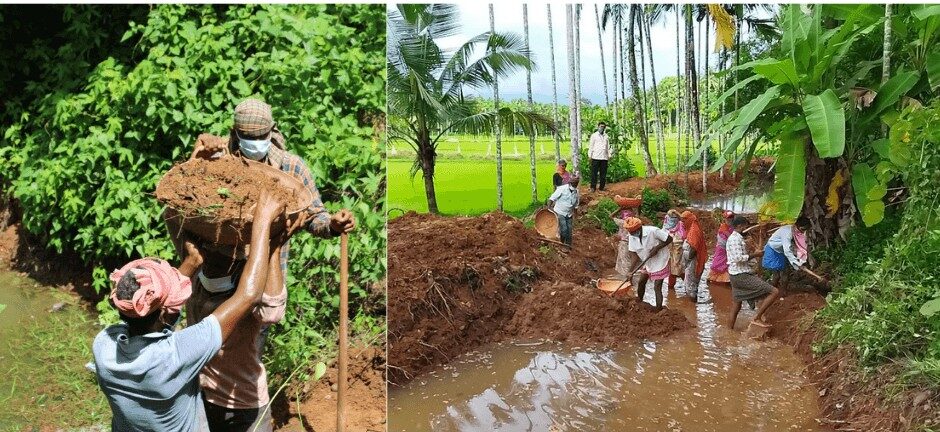The United Nations observes the years between 2021 and 2030 as the ‘decade of Ecological Restoration’, with the aim to “prevent, halt and reverse the degradation of ecosystems…to end poverty, climate change and mass extinction.” It highlights the inextricable link between ecological and socioeconomic systems and re-emphasizes the duty of States to guarantee conservation as well as the sustainable management of natural resources that are fundamental to livelihoods.
In that regard, rural India has witnessed the widespread degradation of natural resources and farming systems, in tandem with inequality when it came to controlling productive assets such as land and water. Add the variable of climate change to this combination, and it sets the stage for conflict over resources and crores of families staring at dwindling incomes in the face. Consider this: 60% of Indian agriculture depends on groundwater, and declining water levels can reduce agricultural productivity by 20-68% by 2025. This will have disastrous social costs on the welfare of households since agriculture is the primary source of livelihood for more than 58% of our population. A healthy ecosystem is therefore indispensable for sustaining major rural economic activities such as agriculture, livestock, and the collection of minor forest produce.
Enter, the MNREGS
The Mahatma Gandhi National Rural Employment Guarantee Scheme (MGNREGS) was not originally designed to respond to climate change risks when it was introduced as an Act for alleviating poverty back in 2005. Apart from guaranteeing the right to work and equal wages for all, the Scheme also enables Panchayats to plan for and undertake community interventions that strengthen the livelihoods of communities, be it restoring and rejuvenating forests, land, or water resources.
Over the years, multiple studies have shown wide-ranging environmental benefits from the MNREGS, such as its ability to build a region’s long-term climate resilience, improve mitigation efforts, and generate green jobs. So much so, that it is possible—and evidence of the same exists—to align the right to work guaranteed under the MGNREGA with the right of every person to maintain their livelihoods by ensuring their resilience to climate change.
Also known as the National Rural Employment Generation Scheme (NREGS), one of the primary objectives of the Scheme is to create durable assets to increase the land and water resources available in rural areas, consequently enhancing the livelihood of communities. 67% of all the permissible work under the Scheme comprises what is known as Natural Resource Management (NRM) activities, which are constructed on commons like pastures, government ‘wastelands’, panchayat land, as well as on the private property of the poor and vulnerable. This includes works on water harvesting, soil conservation, irrigation facilities, renovating traditional water bodies, developing and drought-proofing land, to name a few. On average, between 2015 and 2020, NRM works constituted 60% of the MGNREGS expenditure.

A series of studies have shown the effectiveness of NRM work in improving several environmental indicators. For instance, a 2011 study conducted in Karnataka revealed that MGNREGS works on land and water has positively affected water percolation, groundwater levels, area under cultivation, soil health, and biomass availability. Similar positive impacts were reported in 2013 by the Indian Institute of Science (IISc) when MNREGS activities in four states across different agro-ecological zones were compared.
MGNREGS assets have also shown to be capable of absorbing sudden shocks from natural disasters like floods and cyclones, thus mitigating their impact on life and livelihood. Recognizing this feature, the Kerala government incorporated MGNREGS as a major activity in its efforts to mainstream ecosystem-based disaster risk reduction activities (Eco-DRR) between 2019 and 2021.
In 2021, the findings of all these studies played out in front of us when we conducted research across rural Rajasthan, where communities have been leveraging the MGNREGS to improve their villages’ water resources and available grazing land.
MGNREGS Assets Insure Agri-Livelihoods in Rural Rajasthan
A decade ago, communities in rural Rajasthan used to pool together labour and resources for building and maintaining water structures or for developing common land. Now, by making available public funds for similar work through the MGNREGS, resource constraints on communities for various activities have eased tremendously.

Building water harvesting structures is an intervention that has reduced locals’ seasonal distresses. “Our village went without water for months…there was no water for our livestock either,” recalls Kamala Devi of Bhilwara district. “The anicuts helped us stop the run-off water and store it. The animals now have enough water even in the summer months,” she tells us, referring to the small check dams built across streams. These retain water that can be later used for irrigation and livestock.
In most parts of Western Rajasthan where water for irrigation is scarce and rainfall scanty, the scheme has been a boon to the locals dependent on agriculture. “Our village receives very less rainfall. Building takas (a water harvesting structure) through MGNREGS allowed us to store rainwater,” says Kesu Lal, a farmer from Barmer district. “After the last rains, I have a tank full of water which is enough to grow crops during the rabi season… [this] water is also used for drinking, which saves us time from having to go far to fetch water,” the MGNREGS beneficiary adds.
The potency of the MGNREGS has also been realized in other ways when it comes to conserving and managing commons, including communities’ ability to collectively protect themselves from the ills of overgrazing. “It was a serious problem in our village,” says Kesulal from Devgarh.
The charagah samiti (village institution for managing common land) decided to demand that a fence be built around the village’s pasture land via the MGNREGS. After we fenced it, it would be closed for six months every year. This way, the grass has enough time to grow back on the land without the animals eating all of it. It has helped [maintain] our livestock tremendously!
Another pan-India IISc study found that Natural Resource Management activities in 2017-18 alone resulted in annual mean sequestration of 62 metric tonnes of carbon dioxide, a figure which “could rise to 249 MtCO2 by 2030”. What set out as anti-poverty legislation has begun finding itself contributing to India’s NDC target of creating a carbon sink of 2.5 to 3 billion tons of CO2 by 2030.
Strengthening the MGNREGA towards Building Climate Resilience
At a base level, the MGNREGS plays a pivotal role as a safety net of wages for rural households, at least for 100 days a year. Every year since its inception in 2005, the demand for work has risen, reaching an all-time peak during the pandemic. Despite this increasing relevance, the scheme is rife with challenges that include but are not restricted to decreased budgetary allocations, delayed payments, and corrupt patronage networks. While “solutions” to these would go well beyond the scope of this story, we have sufficient reason to focus on improving the scheme insofar as building adaptive resilience to climate change goes.
The institutional architecture of the MNREGS—the rights-based social protection, inclusion of women and marginalized communities, participatory planning of activities, and mandate for providing public funds to enhance livelihood assets—provides a strong foundation for large scale change. The scheme benefits a large number of women who are enrolled as mates and workers while prioritizing assets that are supposed to serve the most vulnerable sections of a village. The demand-driven nature of the program activates decentralized institutions like gram sabhas, thereby enabling community participation in planning.

As a starting point for leveraging the full potential of the Scheme, MGNREGS should be recognized as an efficient vehicle for large-scale, scientifically-planned, community-led ecological restoration across the country. As MGNREGS activity planning is done at the panchayat level, it allows for cost-effective micro-targeting and can cater to the restorative needs of every nook and cranny.
Second, to implement planning effectively, there is a need to both strengthen the capacity of Panchayati Raj Institutions (PRIs) and communities for making ecologically sound and locally suited eco-restoration plans. Community-centric planning that strategically accounts for variations in the local climate when creating assets is essential for building adaptive capacities at the micro-level.
Third, village commons are an important source of livelihood and food security for the landless and most vulnerable as they provide valuable assets like firewood, fodder, non-timber forest produce (NTFPs) and several others. Activities on commons such as pastures, forests, grasslands, water bodies, mangroves and wetlands need to be promoted, as they are likely to have the maximum impact on the lives of the poor. These were found to have seen a decline between 2016 and 2019.
Fourth, ecologically fragile zones like hilly areas, which are frequently prone to landslides, or coastal areas, can benefit from well-planned green infrastructure (like flood channels, mangrove plantations etc.) through MGNREGA. With the help of early warning systems and green infrastructure, they can mitigate the effects of natural disasters. This also necessitates the integration and capacity building of the MNREGS into disaster mitigation plans in the first place.
Finally, the State of Working in India Report 2019 released by Azim Premji University discussed how an urban employment guarantee scheme similar to the MGNREGA can be used for urban ecological restoration. For example, Kerala’s Ayyanakali Urban Employment Guarantee Scheme includes eco-restoration works in urban centres; with proper planning, such urban restoration can enhance the quality of life in India’s cities.
At COP14 in New Delhi, India pledged to restore 26 million hectares of land by 2030. However, it is significant to note that about 29% of India’s land (almost 96.4 million hectares) is in a permanent state of degradation, costing 2.5% of the country’s GDP. Post-pandemic, MNREGS and urban employment schemes should be seen as an opportunity for the large-scale generation of green jobs for restoration activities; estimates say this can create 1058 million days of labour and provide jobs to 5.2 million individuals at the rate of 200 days of guaranteed work, per worker.
In all, the Mahatma Gandhi National Rural Employment Scheme can significantly enhance ecosystem services in rural India, all the while securing, sustaining, and creating new livelihood opportunities in auxiliary fields. There are obvious multiplier effects on other well-being indicators like public health, sanitation, etc. from resuscitating degraded land, improving irrigation facilities, and recharging a region’s groundwater table. Be it academic research or tales from the field, the verdict is loud and clear: the MGNREGS is an opportunity for scaling up restorative activities that ensure resource sustainability for vulnerable communities across India, all the while assuring them of the right to work.
Featured image of a water channel being de-silted in Karnataka’s Dakshina Kannada district, courtesy Anirudh Sravan P.







[…] Read more about this in the article written by FES’ Richu Sanil and Deepannita Misra in The Bastion. […]
[…] energy projects within the purview of the Mahatma Gandhi National Rural Employment Guarantee Act (MGNREGA). This would create direct employment within the RE sector while also ensuring a sense of ownership […]